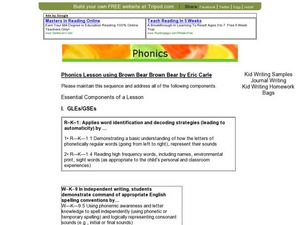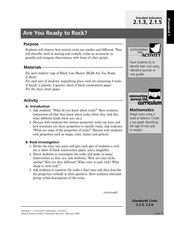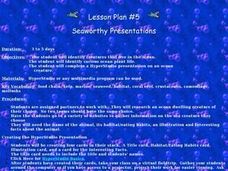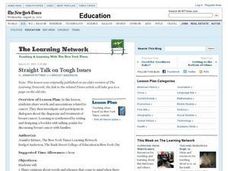Curated OER
My Little Seed House
First graders read a story. In this seeds lesson, 1st graders read The Tiny Seed and make their own seed house. Students write down their observations and complete a worksheet.
Curated OER
Brown Bear Phonics
Students listen to Brown Bear, Brown Bear and imitate the style of Eric Carle in writing a sentence. In this writing lesson, students use the beginning and ending sounds of words to write an Eric Carle type sentence. Students create...
Curated OER
Are You Ready to Rock?
Second graders investigate rock samples using magnifying class. In this earth science lesson, 2nd graders identify the physical properties and describe them verbally with their partners. They compare their findings with the class.
Curated OER
Environment: The River Classroom
Seventh graders engage in hands-on experiments and activities dealing with rivers and greenways. They also observe lectures and demonstrations by experts in water and river restoration. Students and teachers participate in canoe trips...
Curated OER
Breaking the Chains: Rising Out of Circumstances
Study history through photographs. In this visual arts and history lesson, students learn to analyze photographs to discover details about life during the Civil War era. Students write journal entries as if they are the African-American...
Curated OER
Cooking Up the Scientific Method
First graders identify the different steps of the scientific method. In this life science lesson, 1st graders apply this method when conducting a series of hands-on activities. They collect data and write observations in their journals.
Curated OER
Does One Tree a Forest Make?
Students take a walk around the schoolyard looking at and identifying the trees. One leaf for each tree is collected. A chart is developed that represents the population of trees on the school ground. They keep journals and write an essay.
Curated OER
A Hard Sell on Stem Cells?
Learners examine their prior knowledge of cell regeneration and therapeutic use of stem cells. After reading an article, they discover new techniques for deriving embryonic stem cells. In groups, they research on the different types of...
Curated OER
Seaworthy Presentations
First graders research ocean animals and plants on the web. For this ocean habitat lesson, 1st graders prepare a multimedia presentation. Students will work on their presentations in pairs and every group should have its own animals or...
Curated OER
All Rights Reserved?
Students explore, through discussion, research, dramatic skits, and writing, the debate over genetic ownership of biological products and evaluate the economic viewpoints of the countries and companies involved.
Curated OER
The Life Cycle of the Butterfly
First graders, after listening to fictional and non-fictional literature about caterpillars, and observing caterpillars from egg to butterfly, write a "biography" of a caterpillar using appropriate vocabulary and time lines.
Curated OER
In the Wake of a Storm
Students share thoughts about the effects of Hurricane Katrina on Louisiana's natural environment. They read an online article and write proposals to save Mississippi River marshlands.
Curated OER
Bottle Habitat
In groups of four, students construct aquatic habitats in pop bottles. They create charts and record data from observations over a four week period. Then they graph their data and write explanations for what they observed.
Curated OER
The Art of Adaptation
Students examine and discuss animal adaptation. They read an article about snakes, conduct research on ways animals adapt, develop a diagram, and write a short story written from the perspective of the animal they researched.
Curated OER
Roy G. Biv Has Feelings Too
Young scholars test their memory recall and discuss its association to color. After reading an article, they discuss the natural and psycho-sociological significance of the color red. As a class, they participate in a mood-color...
Curated OER
Waste Not, Want Not
Young scholars consider the types of debris that litters beaches and conduct research on waste management. They then interview professionals in a particular field of waste management and write reports for a booklet about garbage and...
Curated OER
Log Book Guidelines
High schoolers are given the guidelines for their log books. The log book first starts with what is the purpose of a log book. Then students have the instructions on how to organize a log book. From there student are given step by...
Curated OER
Carrot Sticks or French Fries?
Young scholars investigate the influence of fast food brand names on food choices and analyze the factors that contribute to branding preferences. They write an opinion essay on the corporate responsibility to influence food choices.
Curated OER
Straight Talk On Tough Issues
Learners engage in a lesson that is focused upon the concept of breast cancer and research is conducted using a variety of reference sources. They reflect upon how different people deal with the tragedy of cancer and then students write...
Curated OER
Mapping Constellations
Students become familiar with constellations. In this space science activity, the teacher introduces constellations by showing students the star patterns and reading myths. Students, observe the stars nightly, then choose one...
NASA
Auroras
In this auroras learning exercise, students define 11 terms related to space phenomena such as auroras, coronal mass ejections and auroral ovals. Students use a given website to help them define the terms and they write a 500 word essay...
Curated OER
To Drink or Not to Drink?
Second graders compare water conservation issues as they impact the past, present, and future in Nevada. For this water conservation lesson, 2nd graders perform and ice experiment to comprehend water collection differences. Students...
Curated OER
What Goes Around Comes Around
Students investigate how the ocean plays a part in the water cycle. In this earth science lesson, students locate a puddle outside and mark it with chalk. Students observe the changes in the water during the next two days.
Curated OER
Variable Skies
Learners examine factors which affect a vortex and create model tornadoes. They identify variables, pose a testable question, and perform an experiment using the scientific method. After they collect their data, students write a complete...

























